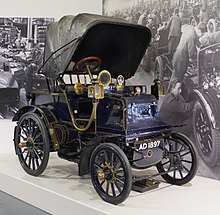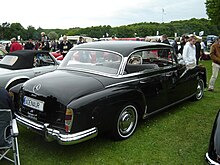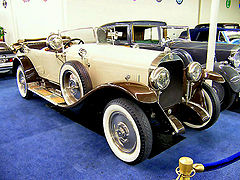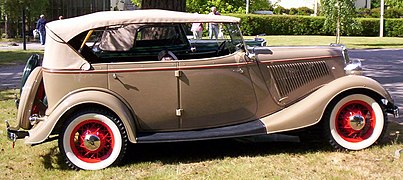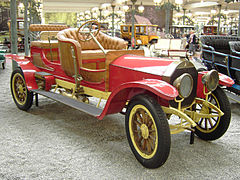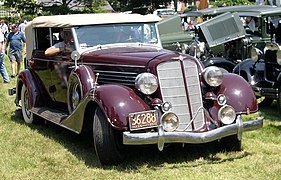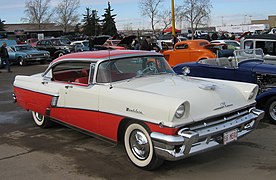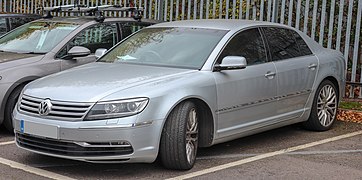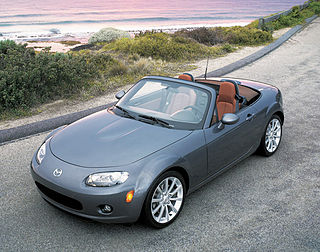
A convertible or cabriolet is a passenger car that can be driven with or without a roof in place. The methods of retracting and storing the roof vary among eras and manufacturers.

A coupe or coupé is a passenger car with a sloping or truncated rear roofline and two doors.

The Chrysler 300 "letter series" are high-performance personal luxury cars that were built by Chrysler in the U.S. from 1955 to 1965 and were a sub-model from the Chrysler New Yorker. After the initial year, which was named C-300 for its standard 300 hp (220 kW) 331 cu in (5.4 L) FirePower V8, the 1956 cars were designated 300B. Successive model years were given the next letter of the alphabet as a suffix, reaching the 300L by 1965, after which the model sequence was discontinued while the "300" remained. At its introduction it was advertised as "America's Most Powerful Car".

A sedan or saloon is a passenger car in a three-box configuration with separate compartments for an engine, passengers, and cargo. The first recorded use of sedan in reference to an automobile body occurred in 1912. The name derives from the 17th-century litter known as a sedan chair, a one-person enclosed box with windows and carried by porters. Variations of the sedan style include the close-coupled sedan, club sedan, convertible sedan, fastback sedan, hardtop sedan, notchback sedan, and sedanet/sedanette.
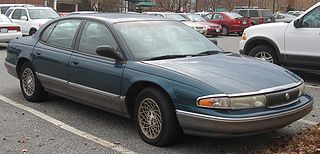
The Chrysler New Yorker is an automobile model that was produced by Chrysler from 1940 until 1996, serving for several decades as either the brand's flagship model or as a junior sedan to the Chrysler Imperial, the latter during the years in which the Imperial name was used within the Chrysler lineup rather than as a standalone brand.
There are many types of car body styles. They vary depending on intended use, market position, location, and the era they were made in.

The Royal was a full-sized automobile produced by the Chrysler Corporation in the United States. It was firstly released in 1933 and continued being built until 1934. Then, the model ended production and did not returned until 1937 - continuing until 1950.

Buick Century is the model name that was used by Buick for a line of upscale full-size cars from 1936 to 1942 and 1954 to 1958, as well as from 1973 to 2005 for mid-size cars.

The Chrysler LeBaron, also known as the Imperial LeBaron, is a line of automobiles built by Chrysler from 1931 to 1941 and from 1955 to 1995. The model was introduced in 1931, with a body manufactured by LeBaron, and competed with other luxury cars of the era such as Lincoln and Packard. After purchasing LeBaron with its parent Briggs Manufacturing Company, Chrysler introduced the luxury make Imperial in 1955, and sold automobiles under the name Imperial LeBaron until 1975. Chrysler discontinued the Imperial brand in 1975, and reintroduced the Chrysler LeBaron in 1977 to what was then Chrysler's lowest priced model.

A hardtop is a rigid form of automobile roof, typically metal, and integral to the design, strength, and style of the vehicle.

The Chrysler Imperial, introduced in 1926, was Chrysler's top-of-the-line vehicle for much of its history. Models were produced with the Chrysler name until 1954, after which it became a standalone brand; and again from 1990 to 1993. The company positioned the cars as a prestige marque to rival Cadillac, Continental, Lincoln, Duesenberg, Pierce Arrow, Cord, and Packard. According to Antique Automobile, "The adjective ‘imperial’ according to Webster's Dictionary means sovereign, supreme, superior or of unusual size or excellence. The word imperial thus justly befits Chrysler's highest priced model."

The Buick Roadmaster is an automobile that was built by Buick from 1936 until 1942, from 1946 until 1958, and then again from 1991 until 1996. Roadmasters produced between 1936 and 1958 were built on Buick's longest non-limousine wheelbase and shared their basic structure with the entry-level Cadillac Series 65, the Buick Limited, and after 1940, the Oldsmobile 98. Between 1946 and 1957 the Roadmaster served as Buick's flagship.

The Mercury Turnpike Cruiser is a series of automobiles that were produced by the Mercury division of Ford for the 1957 and 1958 model years. Named to commemorate the creation of the Interstate Highway System, the Turnpike Cruiser was marketed as the flagship Mercury model line, slotted above the Montclair when Mercury was positioned upmarket to luxury status when Edsel was introduced in 1958.

The Mercury Park Lane is a full-sized automobile that was produced by the Mercury division of Ford Motor Company. While not officially introduced as the replacement of the Mercury Turnpike Cruiser, the Park Lane became the flagship of the Mercury model line upon its introduction. The second-generation Park Lane was positioned above the Mercury Montclair.

The Buick Limited was Buick's flagship model line between 1936 and 1942, and, in celebration of GM's Fiftieth Anniversary, a single-year halo car for the Division in model year 1958. Since the 1960s Buick has intermittently used the term "Limited" as a designation denoting its highest level of trim and standard features in its various model ranges.

The Newport was a name used by Chrysler for both a hardtop body designation and also for its lowest priced model between 1961 and 1981. Chrysler first used the Newport name on a 1940 show car, of which five vehicles were produced. The Newport continued the tradition of a large, comfortable luxurious coupe and sedan, while offering a modestly priced product in comparison to the Chrysler New Yorker and Chrysler Imperial. The Newport gradually replaced the Chrysler Windsor which originally replaced the Chrysler Royal. The Newport was initially the brand name for the Windsor with a hardtop body style, then was used for coupes, sedans and station wagons in later decades.
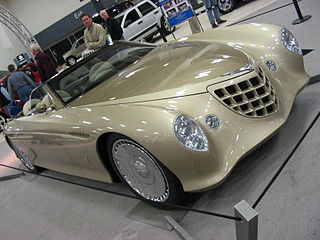
The Chrysler Phaeton was a four-door convertible sedan concept car built by Chrysler in 1997.
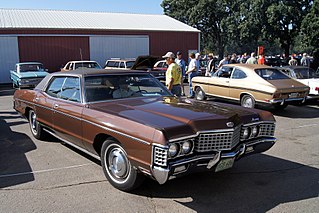
The Mercury Monterey is a series of full-size cars that were manufactured and marketed by the Mercury division of Ford from 1952 to 1974. Deriving its name from Monterey Bay, the Mercury Monterey served as the upscale version of the Mercury Custom which replaced the Mercury Eight, the debut model line of the Mercury division. During its production, the Monterey would be offered in multiple body styles, ranging from coupes, convertibles, sedans, hardtops, and station wagons.

The Buick Super is a full-sized automobile produced by Buick from 1940 through the 1958 model years, with a brief hiatus from 1943 through 1945. The first generation shared the longer wheelbase with the top level Roadmaster while offering the smaller displacement engine from the Buick Special. The Super prioritized passenger comfort over engine performance. For several years, it was called the "Buick Eight" or "Super Eight" due to the engravement on the grille while all Buick's since 1931 were all installed with the Buick Straight-8 engine with varying engine displacement.

The Chrysler Six was a series of cars that were all installed with the Chrysler Straight Six when the company assumed operations of the Maxwell Automobile Company in 1924, and Chalmers Automobile Company in 1926. The Chrysler Six initially consisted of several Models, then Series designations that originally declared the approximate top speed each vehicle was able to consistently maintain, then each series number was incrementally updated every new model year, and each series was offered in several body style choices. The engines were technically advanced for their time and were entered in the 24 Hours of Le Mans for 1925, 1928 and 1929.
